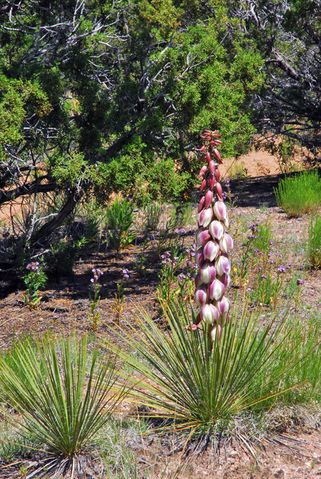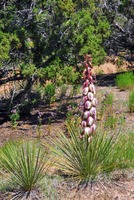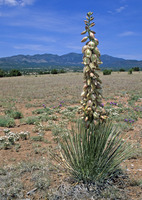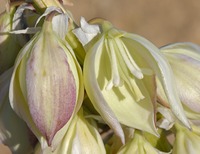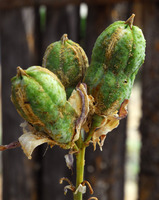Plants cespitose, forming widely separated colonies, acaulescent or occasionally caulescent; rosettes 1-5 per colony, usually small. Stems erect, simple, shorter than 1 m. Leaf blade linear, plano-convex or plano-keeled, widest near middle, 33-65 × 0.5-0.8 cm, slightly flexible, margins entire, white to grayish. Inflorescences mostly green, racemose, sometimes paniculate proximally, occasionally paniculate and long-racemose distally, arising within rosettes, (5-)7-13 dm, glabrous; bracts erect; peduncle scapelike, 0.1-0.5 m, to 2.5 cm diam. Flowers pendent; perianth campanulate or rarely globose; tepals distinct, cream or greenish, often tinged rose or rosy brown, narrowly elliptic to broadly elliptic, 5.5-7 × 2-3.2 cm; filaments to 2.5 cm; anthers 3.2-4.8 mm; pistil 1.5-3.2 cm; style white or pale yellowish green, 7 mm; stigmas lobed. Fruits erect, capsular, dehiscent, oblong-cylindric, occasionally constricted at middle, 5-5.7 × 2-2.5 cm, dehiscence septicidal. Seeds glossy or dull black, thin, 6-10 mm.
Flowering spring. Juniper-pinyon pine woodlands to adjacent grasslands; 1100--2100 m; N.Mex.
J. M. Webber (1953) believed Yucca intermedia to be a hybrid between Y. glauca and Y. angustissima or Y. baileyi. S. D. McKelvey (1938-1947) recognized var. ramosa based primarily on paniculate inflorescences. Plants of this type are found in the southeastern area of the species range, where populations with only paniculate inflorescences occur, as well as populations with racemose and paniculate inflorescences.
Duration: Perennial
Nativity: Native
Lifeform: Shrub
General: Acaulescent to occasionally caulescent plant from a woody caudex; stems, when present, erect, unbranched, shorter than 1 m; plants form small, widely separated colonies, with 1-5 rosettes per colony.
Leaves: Leaf blade long and narrow, half-circle shaped in cross section (one surface flat and the other rounded), widest near middle, 33-65 cm long by 5-8 mm wide, slightly flexible, the margins smooth, white to grayish.
Flowers: Inflorescences mostly green, racemose, sometimes paniculate toward the bottom, arising within rosettes, 50-130 cm tall, glabrous; flowers pendent; perianth campanulate or rarely globose, cream or greenish, often tinged rose or rosy brown, 6-7 cm long.
Fruits: Capsules erect, oblong-cylindric, occasionally constricted at middle, 5-6 cm long, splitting open when mature to release the seeds. Seeds glossy or dull black, thin, 6-10 mm
Ecology: Found in juniper-pinyon pine woodlands and adjacent grasslands, from 3,500-4,000 ft (1067-1219 m); flowers in the spring.
Distribution: Central and northeastern New Mexico
Notes: Allred and Ivey treat this taxon as a variety of Y. baileyi, and indeed the two species are quite similar. According to Allred, they are distinguished by the height of the inflorescence. Y. baileyi has shorter raceme, 25-80 cm long (distance from lowest flower to highest flower), on a shorter stalk, less than 20 cm long, with most of the flowers well embedded among the rosette leaves. Y. intermedia has a longer raceme, 70-130 cm (although sometimes shorter), on a longer stalk, 10-50 cm long, with the lowest flowers elevated to about the tips of the leaves. The species has been considered a hybrid between Y. glauca and Y. angustissima or Y. baileyi, though not based on any genetic evidence. It is considered a challenging taxon to precisely define, because of the similarities with its hypothesized parent species. It is the Yucca commonly seen in central New Mexico, and is commonly believed to be restricted to that state.
Ethnobotany: Yucca roots were used to make soap and shampoo, and had ceremonial uses.
Etymology: Yucca comes from Haitian word yuca, or manihot, because young inflorescences are sometimes roasted for food; intermedia means in between, probably referring to its hypothesized hybrid origins.
Synonyms: Yucca intermedi, Yucca baileyi. var. intermedia
Editor: AHazelton 2015


